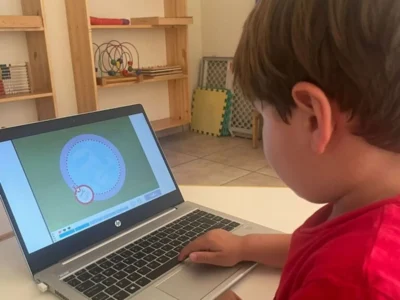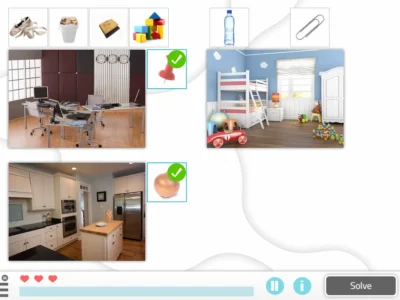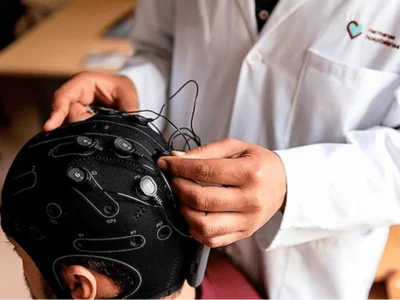Neuropsychologist Sofía Fonseca explains how HRV biofeedback can improve cognition in older adults from a clinical perspective and presenting the available evidence.
Introduction
In the first part of this article we explored how heart rate variability (HRV) is linked to cognitive performance in old age. As we age, this variability tends to decrease, affecting not only physical health, but also attention, memory and other critical mental functions. Faced with this panorama, key clinical questions arise: Can we intervene on HRV?; Are there validated techniques to improve it?; Can this impact cognition?
Next, we address HRV biofeedback, a non-invasive intervention that allows the autonomic nervous system to be trained through respiratory self-regulation. We will analyze how it works, what evidence supports its use in older adults and what applications it has in the context of cognitive stimulation and neuropsychological rehabilitation.
HRV biofeedback and cognitive functions
What is biofeedback and how does it work?
Biofeedback is a technique whose goal is for the individual to learn to voluntarily control responses of different biological processes (Carrobles, 2016), by decreasing or increasing the probability of a physiological response occurring, by associating it with some consequence (Moscoso, 1984).
This technique is an evidence-based practice, that is, it is based on evidence obtained from research to guide the provision of health services, and it has been tested and proven in research and clinical practice (Yucha & Montgomery, 2008).
The procedure consists of recording a subject’s specific physiological activity using electronic devices and specialized software. The system is programmed so that, when the subject succeeds in evoking the desired physiological activity, they receive immediate and precise feedback through auditory or visual stimuli. By associating this feedback with the physiological response, the subject learns to identify it and, through training, manages to modulate it voluntarily. It is essential that the information is presented in real time, so that the subject can perceive the changes and learn to control them effectively (Yucha & Montgomery, 2008).
What types of biofeedback are there?
There are different types of biofeedback, depending on the physiological system being monitored, which are described below (Yucha & Montgomery, 2008):
- Electromyographic: measures the electrical activity of the muscles.
- Temperature: records peripheral temperature.
- Electroencephalographic (EEG or neurofeedback): records brain electrical activity.
- Galvanic skin response: records changes in the skin’s electrical conductance, sensitive to sweat.
- Respiratory: records the rhythm and depth of breathing.
- Heart rate variability (HRV): focuses on regulating heart rhythm.
In summary, biofeedback is a therapeutic tool that allows individuals to gain greater control over some of their physiological functions that normally operate automatically, through a learning process based on real-time feedback. Its usefulness has been supported by numerous scientific studies and its application has expanded to various clinical contexts such as stress management, anxiety, chronic pain, neurological disorders and cognitive optimization, among others.
HRV biofeedback
HRV biofeedback has been applied to various medical and psychiatric conditions such as asthma, anxiety, depression, chronic pain, among others (Moss, 2004). It consists of increasing heart rate variability by stimulating the baroreflex and respiratory sinus arrhythmia, through the modulation of breathing rate (Khazan, 2013).
- The baroreflex is a mechanism of the autonomic nervous system that helps maintain stable blood pressure, it operates through receptors located in the arteries (called baroreceptors) that detect changes in pressure and send signals to the brain to adjust heart rate and the diameter of blood vessels, thus promoting cardiovascular balance.
- Meanwhile, respiratory sinus arrhythmia (RSA) is a rhythmic fluctuation of the heart rate (HR) that accompanies breathing, with inhalation HR rises and with exhalation it falls (Khazan, 2013; Lehrer & Gevirtz, 2014).
To achieve HRV training with this technique, it is necessary to monitor pulse and breathing at the same time and the variations in these signals are displayed on a computer screen; the person receiving training uses the information from the computer to regulate these functions by modulating their breathing.
Sessions and personalization of HRV
It has been shown that 4 to 10 sessions of this type of training are required to achieve an increase in HRV (Yucha & Montgomery, 2008). The objective is to increase it by stimulating the baroreflex and respiratory sinus arrhythmia, through the modulation of breathing rate (Khazan, 2013).
To personalize the treatment, in the first session HRV is determined and the person’s optimal breathing rate is identified. For this, two electrodes are placed, a photoplethysmograph on the index finger of the left hand to monitor pulse, and an electrode around the diaphragm to record breathing.
Subsequently, to identify the optimal breathing rate, the person is asked to breathe at different rhythms (6.5, 6, 5.5, 5 and 4.5 breaths per minute), for a couple of minutes each. With this information, the breathing rate that produces the greatest increase in HRV is identified, which indicates a better activation of the parasympathetic nervous system and a greater capacity for autonomic regulation. For the following sessions, the person learns to breathe at their optimal breathing rate, which will synchronize with their heart rate (Eddie et al., 2015; Moss, 2004; Theodore et al., 2002).
Currently there are no contraindications or risks associated with HRV biofeedback (Eddie et al., 2015); it has been used safely for the treatment of chronic obstructive pulmonary disease (Giardino et al., 2004), to improve cardiac function after myocardial infarction and in subjects with heart disease (Del Pozo et al., 2004; Nolan et al., 2005).

Subscribe
to our
Newsletter
Evidence on the effects of biofeedback on improving cognitive functioning
HRV biofeedback has proven effective for improving cognitive functions and emotional skills.
A study by Kim and colleagues showed that, after an HRV biofeedback training program, people with severe brain injury increased their HRV and also showed improvements in emotional regulation, working memory, attention and problem-solving. These results suggest that this intervention may be useful as a complementary tool in cognitive rehabilitation (Kim et al., 2013).
A study by Kim and colleagues showed that, after an HRV biofeedback training program, people with severe brain injury increased their HRV and also showed improvements in emotional regulation, working memory, attention and problem-solving. These results suggest that this intervention may be useful as a complementary tool in cognitive rehabilitation (Kim et al., 2013).
This intervention has also shown benefits in older adults, especially in reducing emotional symptoms and improving cognitive functions.
A study by Jester and colleagues evaluated the effects of an HRV biofeedback intervention in this group, observing a significant decrease in depression and anxiety symptoms after training, as well as improvements in attentional skills and, to a lesser extent, executive functions. These results suggest that HRV biofeedback can be a useful tool in interventions aimed at emotional and cognitive well-being in older adults (Jester et al., 2018).
Challenges, limitations and ethical considerations
One of the main challenges in the application of biofeedback is accessibility and training of professionals.
In Latin America, the availability of specialized biofeedback equipment is limited, and its costs are usually high. In addition, the dissemination of knowledge about this technique is still somewhat scarce, which reduces its implementation in clinical settings. Despite this, there are efforts to promote its use, such as the work carried out by the Mexican Society of Bio and Neurofeedback, for example, which seeks to encourage training and professional application in Mexico.
Regarding methodological limitations, although there is a growing research base on biofeedback in general, studies that specifically evaluate the effects of HRV biofeedback on cognitive functioning remain limited, particularly when working with older adult populations, since this represents an additional challenge due to factors such as the presence of medical comorbidities, polypharmacy and heterogeneity in the aging, which makes it somewhat complicated to conduct highly controlled studies in the sample.
Finally, it is important to mention that ethical aspects must be considered when implementing biofeedback interventions. It is essential that biofeedback interventions be applied only by professionals who are properly trained and educated in the health field. To ensure the safety and effectiveness of the treatment, it is necessary to request official professional credentials, as well as training certificates backed by recognized and reputable academic institutions or associations. This helps prevent irresponsible practice or the actions of people without adequate preparation, protecting patients from possible harm and from the risk of falling into the hands of people who could offer unfounded or unethical treatments.
Conclusion
In conclusion, heart rate variability (HRV) biofeedback represents a promising tool to improve both physical health and cognitive functioning, especially in aging. This is because HRV is a key indicator of physiological flexibility and of the autonomic nervous system’s ability to adapt to different situations, such as stress—functions that tend to decline with age. Various studies have indicated that training HRV through biofeedback can promote emotional regulation, attention, executive functions and other cognitive skills commonly affected in older adults.
One of the advantages of this intervention is that it can be personalized, since in the initial assessment the individual’s breathing rate that generates the greatest increase in HRV is identified, which is associated with better activation of the parasympathetic nervous system and a greater capacity for autonomic self-regulation. In addition, to date no contraindications or risks associated with its use have been reported.
However, despite encouraging preliminary results, more scientific evidence is needed based on methodologically sound designs and large samples that support its efficacy in this population. To ensure a safe and effective application, these interventions should be carried out by trained professionals with specific health training, adapting protocols to the particular characteristics of each person, especially considering comorbidities and conditions inherent to old age.
If you didn’t get to read the first part of this article about how heart rate variability (HRV) influences cognitive decline, you can consult it here.
Bibliography
- Carrobles, J. A. (2016). Bio/neurofeedback. Clinica y Salud, 27(3), 125–131. https://doi.org/10.1016/j.clysa.2016.09.003
- Del Pozo, J. M., Gevirtz, R. N., Scher, B., & Guarneri, E. (2004). Biofeedback treatment increases heart rate variability in patients with known coronary artery disease. American Heart Journal, 147(3), 545. https://doi.org/10.1016/j.ahj.2003.08.013
- Eddie, D., Vaschillo, E., Vaschillo, B., & Lehrer, P. (2015). Heart rate variability biofeedback: Theoretical basis, delivery, and its potential for the treatment of substance use disorders. Addiction Research and Theory, 23(4), 266–272. https://doi.org/10.3109/16066359.2015.1011625
- Giardino, N. D., Chan, L., & Borson, S. (2004). Combined heart rate variability and pulse oximetry biofeedback for chronic obstructive pulmonary disease: Preliminary findings. Applied Psychophysiology Biofeedback, 29(2), 121–133. https://doi.org/10.1023/B:APBI.0000026638.64386.89
- Jester, D., Rozek, E., & McKelley, R. (2018). Heart rate variability biofeedback: implications for cognitive and psychiatric effects in older adults. Aging y Mental Health, 23(5), 574–580. https://doi.org/10.1080/13607863.2018.1432031
- Khazan, I. Z. (2013). The Clinical Handbook of Biofeedback : a Step-by-Step Guide for Training and Practice with Mindfulness. Wiley.
- Kim, S., Zemon, V., Cavallo, M. M., Rath, J. F., Mccraty, R., & Foley, F. W. (2013). Heart rate variability biofeedback, executive functioning and chronic brain injury. Brain Injury, 27(2), 209–222. https://doi.org/10.3109/02699052.2012.729292
- Lehrer, P. M., & Gevirtz, R. (2014). Heart rate variability biofeedback: How and why does it work? Frontiers in Psychology, 5(JUL), 756. https://doi.org/10.3389/fpsyg.2014.00756
- Moscoso, M. S. (1984). El condicionamiento operante en biorretroNutrition. Revista Latinoamericana de Psicología, 16, 61–76.
- Moss, D. (2004). Heart rate variability and biofeedback. Psychophysiology Today: The Magazine for Mind-Body Medicine, 1, 4–11.
- Nolan, R. P., Kamath, M. V., Floras, J. S., Stanley, J., Pang, C., Picton, P., & Young, Q. R. (2005). Heart rate variability biofeedback as a behavioral neurocardiac intervention to enhance vagal heart rate control. American Heart Journal, 149(6), 1137. https://doi.org/10.1016/j.ahj.2005.03.015
- Theodore, J. L. V., Corydon Hammond, D., Trudeau, D., Monastra, V., Perry, J., Lehrer, P., Matheson, D., & Sherman, R. (2002). Template for developing guidelines for the evaluation of the clinical efficacy of psychophysiological interventions. Applied Psychophysiology Biofeedback, 27(4), 273–281. https://doi.org/10.1023/A:1021061318355
- Yucha, C. B., & Montgomery, D. D. (2008). Evidence-based practice in biofeedback and neurofeedback. In Wheat Ridge, CO: AAPB.
Frequently asked questions about HRV biofeedback
1. What is HRV biofeedback?
It is a technique that allows the patient to learn to control their heart rhythm through visual or auditory feedback in real time, generally through guided breathing.
2. What benefits does biofeedback have for older adults?
It improves emotional self-regulation, attention, memory and other cognitive functions, as well as reducing symptoms of anxiety or stress.
3. How is HRV biofeedback applied in clinical practice?
Sensors that measure breathing and heart rate are used while the patient follows a controlled breathing pattern and observes their results in real time.
4. How many biofeedback sessions are recommended?
Although it varies depending on the case, protocols usually include between 6 and 10 sessions of 30-60 minutes to achieve significant effects.
5. Does HRV biofeedback replace other forms of cognitive stimulation?
No. It is a complementary tool that can enhance the effects of other cognitive intervention programs or neuropsychological therapies.
If you liked this blog post about the HRV biofeedback to improve cognition in older adults, you will surely be interested in these NeuronUP articles:
“This article has been translated. Link to the original article in Spanish:”
Biofeedback de la VFC para mejorar la cognición en adultos mayores: Una herramienta basada en evidencia







 Heart Rate Variability (HRV) and Its Relationship with Cognitive Decline
Heart Rate Variability (HRV) and Its Relationship with Cognitive Decline
Leave a Reply